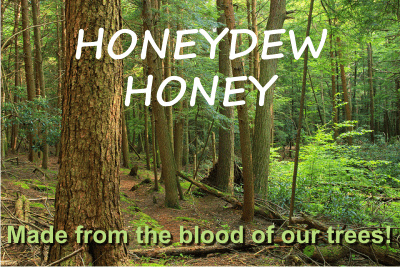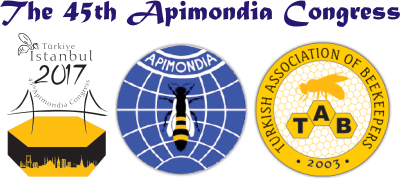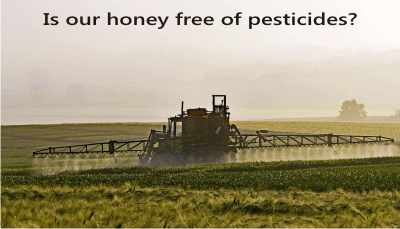Some say it is the sweetest natural food. There are many sugars (carbohydrates) in honey and they all count for its sweetness. However, the sweet taste is different with each type of honey, as they all contain different types of sugar.
Why is honey so sweet?
Because it is made from the nectar honey bees find in flowers, which is really sweet. And because other sugars are subsequently formed under enzymatic process.
What is the nectar of a flower?
A liquid secreted by plants in glands called nectaries, either within the flowers or by extrafloral nectaries. Honey bees are attracted to both forms of this nectar. They resort to extrafloral nectar whenever the plant doesn’t have enough nectar into the flower (as it is the case with cotton, when they choose the nectar found in the first 2 days of the blossom and then turn to extraforal sources).
Extrafloral nectar
It’s a less common type of nectar. Its composition differs from floral nectar, varies by taxa, and may or may not flow in a daily pattern. Generally it is about 95% sugar and 5% a wide array of amino acids and other important nutrients.
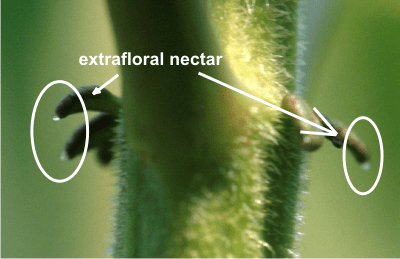
Why does a plant secrete extrafloral nectar?
Scientists have come with 2 possible functions:
1. as an excretory organ for the plant to rid itself of metabolic wastes
2. to attract beneficials for plant defense, by providing a nutrient source to some animal mutualists, which in turn will protect the flower from being eaten by herbivore animals. Many insects have been observed feeding on it: ladybirds, ants (a great many species of vines have EFN and the evolution and selection for EFN is hypothesized to occur as a direct result from the ants using the vines frequently as natural pathways into the forest canopy).
Examples of flowers that produce extraflower nectar: Passion flower (Passaflora spp.), partridge pea (Cassia spp.), hairy vetch (Vicia sp.) and elderberry (Sambucus spp.) – common Florida plants with large extrafloral nectar on the leaves and/or stems. Also easy to find on most cultivars of peach and Prunus spp. in general.
Flower nectar
Depending on the species, a flower’s nectaries can be located on its petals, anthers, stamens, sepals, pistils, styles, ovaries or other parts of the flower. With this nectar flowers attracts pollinating insects. Common nectar-consuming pollinators include mosquitoes, hoverflies, wasps, bees, butterflies and moths, hummingbirds, and bats.
But not all flowers produce nectar. As a rule, nectar is produced as a food reward to attract pollinators. Plants that are wind pollinated, for example, will not produce nectar. Some plants are hermaphroditic, meaning they’re both male and female. These plants tend to produce nectar every day.
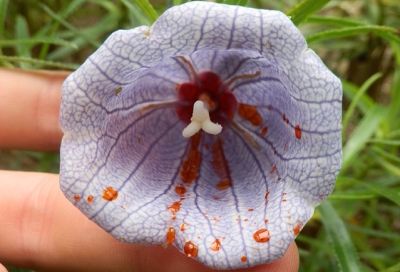
To attract pollinators the flower itself is the signal and the nectar is the reward. The nectar is clear, transparent. But some flowers, like some on Mauritius, that change this pattern. Trochetia boutoniana (see picture) shows off dark red nectar against a blue background and Trochetia blackburniana produces yellow nectar, which it shows off at the center of a yellow flower.
The invasive plant called purple loosestrife (Lythrum salicaria), in Minnesota, has a nectar that is faintly green in color. (“It makes honey gathered by local bees the same color as motor oil.” – says Givesgoodemail from Minnesota.)
Nectar composition differ from flower to flower and some are more attractive to certain pollinators. For example:
– butterflies are very attracted to dandelions, thistle, Centranthus ruber, pink Jupiter’s beard, and lantanas in numerous colors.
– hummingbirds are attracted to lupine, California fuchsia and mimulus, sometimes called monkey flower. They also monarda (with pink, red or purple flowers), penstemon, aquilegia or columbine and digitalis or foxglove. Or the annual cardinal climber, Ipomoea sloteri, commonly known as the hummingbird vine.
– bees have their favorites, too. While hummingbirds are attracted to red flowers, bees are often attracted to blue ones: salvia, Russian sage, catnip, wisteria and sea holly, borage or eryngium. But also penstemon, California fuchsia, verbena and lamb’s ear or stachys. And to herbs such as rosemary, basil, calamint and lavender.
Composition of nectar:
Nectar is a sugar solution of varying concentration, from 5 to 80 %. About 95% of the dry substance are sugars, the rest are amino acids (ca. 0.05 %), minerals (0.02-0.45 %) and small amounts of organic acids, vitamins and aroma compounds.
Honey bees are attracted to flower nectar according to its quantity of sugar. They prefer nectar with higher sugar content, around 50% and will not forage at all if sugars are below 5%. Bees gather this nectar for their energy needs provided by sugar. The greater the sugar value of a plant, the more it is visited by bees for foraging.
The sugar value ranges widely, from 0.0005 to 8 mg. The principal sugars in nectar are fructose, glucose and sucrose.
Sugar concentration depends on species and different climatic factors as temperature, soil, humidity and season. Therefore it is not possible to foresee nectar production.
· Humidity: when humidity is higher the nectar quantity is greater, but the sugar concentration is smaller.
· Temperature: the optimum temperatures are between 10 to 30°C.
· Wind: strong winds diminish nectar secretion.
· Daytime: maximum secretion is at noon and in the early afternoon.
Sugar consistency in different types of monofloral honey:
There have been more than 25 different sugars identified in honey, comprising about 95 % of honey dry weight. (Donner 1977, SIDDIQUI, 1970)
Fructose (averaging 38%) and glucose (averaging 31%) are the main sugars in honey, monosaccharides, that is, simple sugars.
Sucrose is also present in some honeys, usually comprising a little over 1% of the composition of honey. It is composed of fructose and glucose linked together, a disaccharide.
Some other sugars are also present in different honeys: maltose (in linden, acacia, lavender), turanose (acacia), erlose, levulose (in cotton honey), melezitose and raffinose (in honeydew honey), perseitol (in avocado honey) etc.
Oligosaccharides are mainly a product of honey invertase (WHITE J W,1975). Read more about Enzymes in Honey.
Other sugars present in honey:
· saccharose
· isomaltose
· maltulose
· melibiose
· nigerose
· kojibiose
· laminaribiose
· α, β – trehalose
· gentiobiose
· melezitose
· 3-α-isomaltosylglucose
· maltotriose
· l-kestose
· panose
· isomaltotriose
· theanderose
· centose
· isopanose
· isomaltotetraose
· isomaltopentaose
· cellobiose
· gentiobiose
· palatinose
· trehalose
· trehalulose
Total sugars in blossom honeys: 79.7g/100g
Total sugars in honeydew honeys: 80.5g/100g
 picture credit bee-hexagon.net
picture credit bee-hexagon.net
The concentrations of these sugars differ from species to species, geographic origin and weather conditions, collection season, mode of storage, bee species, and even interactions between chemical compounds and enzymes in the honey.
As seen in the table above, there are differences in the composition of sugars between honeydew and blossom honeys. Honeydew honey is characterized by a higher concentration of oligosaccharides, mainly the trisaccharides melezitose and raffinose, which are usually not found in blossom honeys.
Almost equal ratio of fructose and glucose:
– clover (medium fructose content)
– tualang (Fructose 29.6% – Glucose 30%)
– star thistle
– sunflower (Fructose 39.2 – Glucose 37.4)
– spearmint (Fructose 36.49% – Glucose 31.07%)
– Tunisian rosemary (Fructose 37.73% – Glucose 36.58%)
– Tunisian Horehound (Fructose 36.77% – Glucose 35.15%)
More glucose than fructose:
– alfalfa
– blue curl (Trichostema lanceolatum)
– cotton (Glucose 36.19%) – also contains Levulose 39.42% and Maltose 4.80%
– dandelion (Fructose 37.4% – Glucose 38%)
– rapeseed (aka rape) (Fructose 38.3% – Glucose 40.5%)
– Kashmiri honey (Fructose 4.48% – Glucose 10.63%)
– willow honey
More fructose than glucose:
– black locust aka acacia or robinia (Fructose 42.7% – Glucose 26.5%)
– beechwood (Fructose 33.8% – Glucose 22.9%)
– blackberry
– buckwheat (Fructose 40% – Glucose 30%)
– chestnut, (very high fructose content, around 40%)
– citrus (Fructose 38.7% – Glucose 31.4%)
– eucalyptus (Fructose 39.1% – Glucose 33.0%)
– fireweed (Fructose 43% – Glucose 31%)
– heather (Fructose even 43.3% – Glucose 32%)
– honeydew (Fructose 32.5 – Glucose 26.2 g/100 g and many other sugars)
– lavender (Fructose 36.0% – Glucose 30.6%)
– linden aka Tilia, lime or basswood – (Fructose 37.5% – Glucose 31.9) also rich in maltose, about 6-8%.
– longan
– jarrah
– manuka
– metcalfa (Fructose 31.6% – Glucose 23.9%) – also contains maltotriose and particularly high amounts of oligomers called dextrins
– oregano (fructose 39% – Glucose 30%)
– palmetto (Fructose 37.53% – Glucose 31.18%)
– phacelia (Fructose 37.3% – Glucose 34%)
– pine (Fructose content 37% – Glucose content 32%)
– red gum (Fructose 35%)
– rhododendron (Fructose 39.1% – Glucose 30.4%)
– rosemary (Fructose 38.4% – Glucose 33.1%)
– sage
– sidr (jujube)
– stringy bark
– strawberry tree (Fructose 37.6% – Glucose 32.7%)
– thyme (Fructose 42.4 – Glucose 30.3)
– tupelo ( Fructose 43.27%)
– yellow box (Fructose 46%)
– Yapunya from Australia (Fructose 42%)
Some honeys, besides glucose and fructose, have more sucrose:
– avocado (also contains Perseitol – a sugar that is specific to avocado honey)
– alfalfa (max 10%)
– acacia (black locust)
– borage (more than 15 g/100 g.)
– clover
– citrus
– honeydew (also contains melezitose)
– lavander
– leatherwood (Tasmanian)
– red gum
– robinia
– sage
Read more about the composition of honey: proteins, enzymes, minerals and trace elements, vitamins, polyphenols, antioxidants.
Sugar concentration influences the crystallization rate
We know honey is liquid. But sometimes honey becomes semi-solid to rock-solid! It doesn’t mean it is bad or spoiled. Crystallization is a normal process that happens to honeys, sooner in some and later in others. With the exception of commercial “pure” honey which is so filtered and pasteurized in order to remain liquid for a longer period of time, that this actually happens. They stay liquid.
Some honeys crystallize sooner than others and this happens due to different sugars contained.
As a rule honeys with more than 28% glucose crystallize fast, while those with less than 28 % remain generally liquid. Read more about crystallization here: Honey Crystallization.
Why are some honeys sweeter than other honeys?
All honeys are sweet, due to the presence of the sugars fructose and glucose. However, fructose is 2.5 times sweeter than glucose. So, those honeys which have more fructose than glucose are more sweeter than those with a higher concentration of glucose.
Fructose is slightly sweeter than sucrose, glucose is less sweet than sucrose, and maltose even less sweet.
The sweet taste will be influenced by acidity, aromas and by crystallization.
Bitter taste:
Bitter honeys, like linden and sweet chestnut, seem less sweet than honeys with weak taste like acacia. Bitterness is also a special characteristics of the world´s most bitter honey harvested in Italy and Greece, from the Strawberry Tree (Arbutus unedo).
Sour taste:
The sour taste depends on the acidity of honey. It may also be influenced by the skills of the beekeeper: if treatments of Varroa with organic acids are not carried according to the prescriptions during the honey flow, they can influence honey taste and make it more sour.
How is honey compared to table sugar?
Table sugar is made of sucrose. Simple, plain sucrose.
Honey has, fructose, glucose, sucrose, maltose, melezitose, levulose and others, in different concentration. But in most honeys fructose is the highest concentration. And fructose is 2.5 sweeter than glucose, which is also sweeter than sucrose.
On average, honey is 1 to 1.5 times sweeter (on a dry weight basis) than sugar.
Liquid honey is approximately as sweet as sugar, yet it contains only 82.4 g carbohydrates/100 g (vs. 100 g for sucrose) and provides only 304 Kcal/100 g (vs. 400 Kcal for sucrose).
The glycemic index ranges from 31 to 78, depending on the variety.
The density of honey is of about 1.36 kilograms per litre.
One tablespoon of honey weighs 21 grams and has approximately 17 grams carbohydrates and 64 calories (kcal).
! Every time I said honey in this article, I referred to raw fresh honey only.
===========
===========
References:
http://edis.ifas.ufl.edu/in175
Food Chemistry by H.-D. Belitz , Werner Grosch, Peter Schieberle
http://onlinelibrary.wiley.com/doi/10.1111/j.1541-4337.2010.00130.x/full
https://www.ncbi.nlm.nih.gov/pubmed/15628134
, , , , . 2007b. Volatile and carbohydrate composition of rare unifloral honeys from Spain. Food Chem 105:84–93.
Stefan Bogdanov, Bee Product Science, February 2014, www.bee-hexagon.net
https://en.wikipedia.org/wiki/Nectar
FIORI, J; SERRA, G; SABATINI, A G; ZUCCHI, P; BARBATTINI, R; GAZZIOLA, F (2000) Dextrins
HPLC analysis in Metcalfa pruinosa (Say) honeydew. Industrie Alimentari 39 (391): 463-466.

